MKTG1271 - B2B Marketing: First Class Corporation Case Study
VerifiedAdded on 2023/06/15
|11
|2158
|90
Case Study
AI Summary
This assignment provides a comprehensive analysis of First Class Trading Corporation, focusing on their B2B marketing strategies. It examines the company's customer analysis, including buyer behavior in both private and public schools, and relationship analysis using the Relationship Analysis Model. The analysis also covers the company's internal aspects such as Customer Relationship Management (CRM), industry network involving suppliers and competitors, and ARA (Activities, Resources, Actors) analysis, identifying key actors, activities, and resources within the company's operational framework. The assignment uses various marketing models and frameworks to assess the company's strengths and weaknesses in the B2B market, particularly in supplying school supplies to elementary schools.

Running head: MARKETING ASSIGNMENT
Marketing Assignment
Name of the Student
Name of the University
Author Note
Marketing Assignment
Name of the Student
Name of the University
Author Note
Paraphrase This Document
Need a fresh take? Get an instant paraphrase of this document with our AI Paraphraser

1MARKETING ASSIGNMENT
Table of Contents
1. Customer Analysis.......................................................................................................................2
1.1 Buyer Behavior Analysis.......................................................................................................2
1.2 Relationship Analysis............................................................................................................4
2. Company Analysis.......................................................................................................................7
2.1 Customer Relationship Management.....................................................................................7
2.2 Industry Network...................................................................................................................8
2.3 ARA Analysis........................................................................................................................9
References......................................................................................................................................10
Table of Contents
1. Customer Analysis.......................................................................................................................2
1.1 Buyer Behavior Analysis.......................................................................................................2
1.2 Relationship Analysis............................................................................................................4
2. Company Analysis.......................................................................................................................7
2.1 Customer Relationship Management.....................................................................................7
2.2 Industry Network...................................................................................................................8
2.3 ARA Analysis........................................................................................................................9
References......................................................................................................................................10
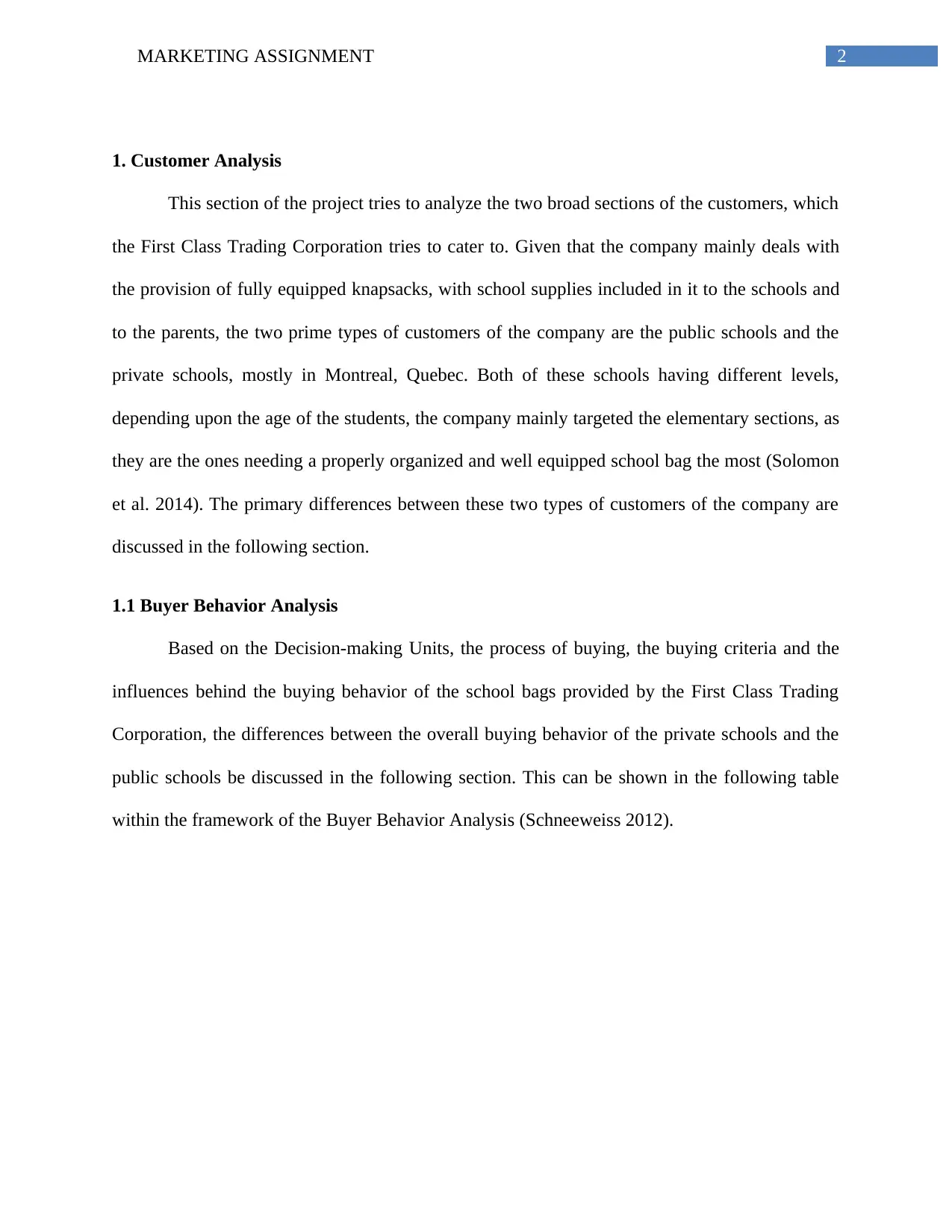
2MARKETING ASSIGNMENT
1. Customer Analysis
This section of the project tries to analyze the two broad sections of the customers, which
the First Class Trading Corporation tries to cater to. Given that the company mainly deals with
the provision of fully equipped knapsacks, with school supplies included in it to the schools and
to the parents, the two prime types of customers of the company are the public schools and the
private schools, mostly in Montreal, Quebec. Both of these schools having different levels,
depending upon the age of the students, the company mainly targeted the elementary sections, as
they are the ones needing a properly organized and well equipped school bag the most (Solomon
et al. 2014). The primary differences between these two types of customers of the company are
discussed in the following section.
1.1 Buyer Behavior Analysis
Based on the Decision-making Units, the process of buying, the buying criteria and the
influences behind the buying behavior of the school bags provided by the First Class Trading
Corporation, the differences between the overall buying behavior of the private schools and the
public schools be discussed in the following section. This can be shown in the following table
within the framework of the Buyer Behavior Analysis (Schneeweiss 2012).
1. Customer Analysis
This section of the project tries to analyze the two broad sections of the customers, which
the First Class Trading Corporation tries to cater to. Given that the company mainly deals with
the provision of fully equipped knapsacks, with school supplies included in it to the schools and
to the parents, the two prime types of customers of the company are the public schools and the
private schools, mostly in Montreal, Quebec. Both of these schools having different levels,
depending upon the age of the students, the company mainly targeted the elementary sections, as
they are the ones needing a properly organized and well equipped school bag the most (Solomon
et al. 2014). The primary differences between these two types of customers of the company are
discussed in the following section.
1.1 Buyer Behavior Analysis
Based on the Decision-making Units, the process of buying, the buying criteria and the
influences behind the buying behavior of the school bags provided by the First Class Trading
Corporation, the differences between the overall buying behavior of the private schools and the
public schools be discussed in the following section. This can be shown in the following table
within the framework of the Buyer Behavior Analysis (Schneeweiss 2012).
⊘ This is a preview!⊘
Do you want full access?
Subscribe today to unlock all pages.

Trusted by 1+ million students worldwide

3MARKETING ASSIGNMENT
Private Schools Public Schools
Recognition
of Problems
DMU- Directors of private elementary
schools, teachers and parent-teacher groups
of the private elementary schools
Influences- Teachers, parents and students,
expectations of the parents regarding the
quality and types of school packs
DMU- Overall the Director General of the
Lester B. Pearson School Board (depending
upon the decisions of the commissioners of
the school board)
Influences- Principals of individual
schools, parents of the students,
expectations of the parents regarding the
quality of products their children are using
Description
of need
DMU- Directors primarily, but also
includes the teachers, also the parents
Influences- Good quality, well equipped
school bags with all necessary stationary
items present in organized ways,
customization and inclusion of individual
names if possible
DMU- Individual school principals
Influences- Expectations of good quality
and wholesome package of products for
their children, which abide by the
conventional standards
Product
Descriptions
DMU- Teachers
Criteria- Determine the quality of the
product according to checklist and the
durability of the product
Influences- Standardized requirements of
the students which the teacher perceived to
be necessary
DMU- Principals
Criteria- Determine the standard of the
product and their utilities
Influences- The perceptions of the parents
of the students regarding the need of the
same
Searching
Suppliers
DMU- Director of each school
Influences- Market, competitors, goodwill
of the company among parents
DMU- Principals at individual school
levels
Influences- Parents and their perceptions
Selection of
Suppliers
DMU- Director of each school
Criteria- Cost effectiveness and quality,
customer services post sales
DMU- DG after approval from each of the
school’s principals
Criteria- Quality and perceptions of the
parents
Submission
of Proposals
DMU- Directory body of each school DMU- DG
Private Schools Public Schools
Recognition
of Problems
DMU- Directors of private elementary
schools, teachers and parent-teacher groups
of the private elementary schools
Influences- Teachers, parents and students,
expectations of the parents regarding the
quality and types of school packs
DMU- Overall the Director General of the
Lester B. Pearson School Board (depending
upon the decisions of the commissioners of
the school board)
Influences- Principals of individual
schools, parents of the students,
expectations of the parents regarding the
quality of products their children are using
Description
of need
DMU- Directors primarily, but also
includes the teachers, also the parents
Influences- Good quality, well equipped
school bags with all necessary stationary
items present in organized ways,
customization and inclusion of individual
names if possible
DMU- Individual school principals
Influences- Expectations of good quality
and wholesome package of products for
their children, which abide by the
conventional standards
Product
Descriptions
DMU- Teachers
Criteria- Determine the quality of the
product according to checklist and the
durability of the product
Influences- Standardized requirements of
the students which the teacher perceived to
be necessary
DMU- Principals
Criteria- Determine the standard of the
product and their utilities
Influences- The perceptions of the parents
of the students regarding the need of the
same
Searching
Suppliers
DMU- Director of each school
Influences- Market, competitors, goodwill
of the company among parents
DMU- Principals at individual school
levels
Influences- Parents and their perceptions
Selection of
Suppliers
DMU- Director of each school
Criteria- Cost effectiveness and quality,
customer services post sales
DMU- DG after approval from each of the
school’s principals
Criteria- Quality and perceptions of the
parents
Submission
of Proposals
DMU- Directory body of each school DMU- DG
Paraphrase This Document
Need a fresh take? Get an instant paraphrase of this document with our AI Paraphraser
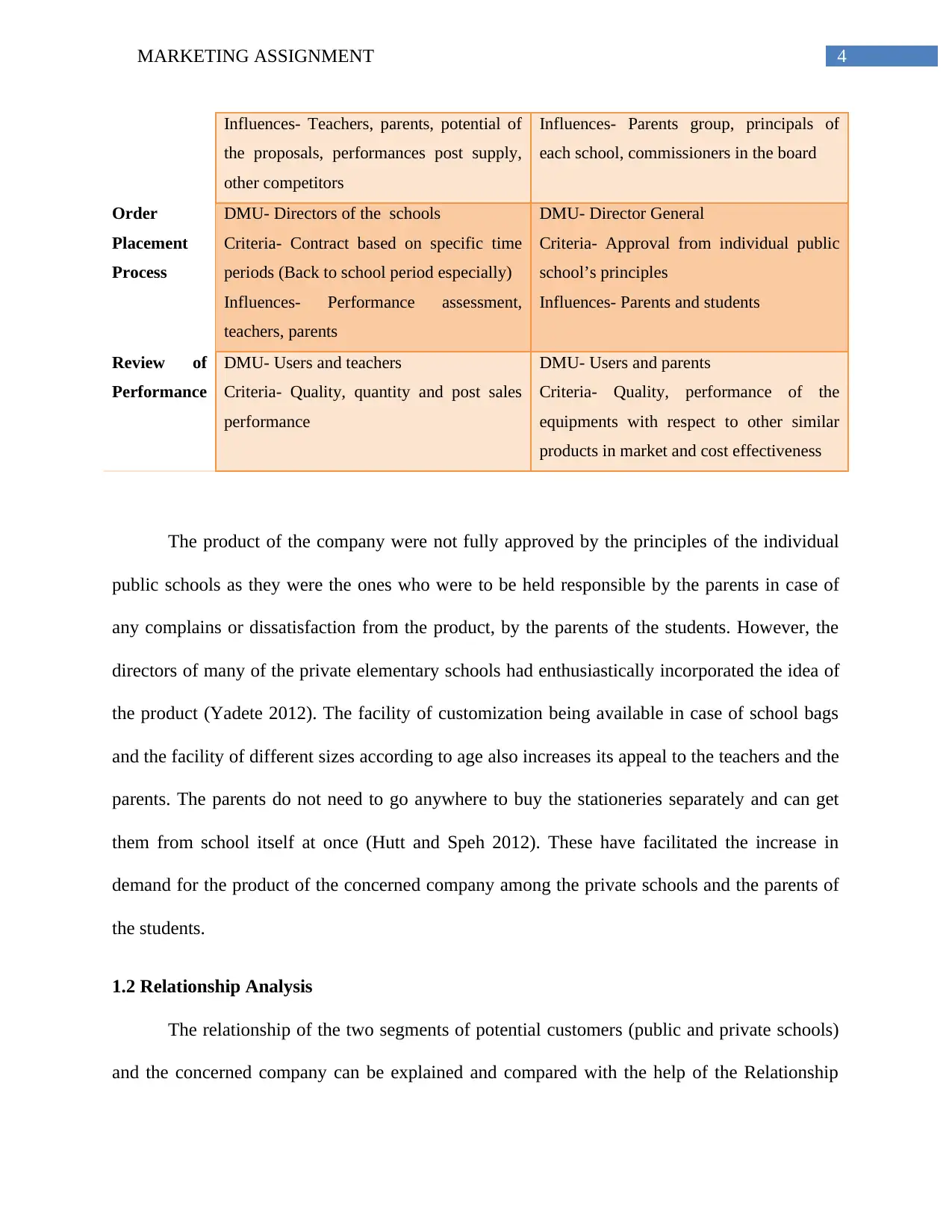
4MARKETING ASSIGNMENT
Influences- Teachers, parents, potential of
the proposals, performances post supply,
other competitors
Influences- Parents group, principals of
each school, commissioners in the board
Order
Placement
Process
DMU- Directors of the schools
Criteria- Contract based on specific time
periods (Back to school period especially)
Influences- Performance assessment,
teachers, parents
DMU- Director General
Criteria- Approval from individual public
school’s principles
Influences- Parents and students
Review of
Performance
DMU- Users and teachers
Criteria- Quality, quantity and post sales
performance
DMU- Users and parents
Criteria- Quality, performance of the
equipments with respect to other similar
products in market and cost effectiveness
The product of the company were not fully approved by the principles of the individual
public schools as they were the ones who were to be held responsible by the parents in case of
any complains or dissatisfaction from the product, by the parents of the students. However, the
directors of many of the private elementary schools had enthusiastically incorporated the idea of
the product (Yadete 2012). The facility of customization being available in case of school bags
and the facility of different sizes according to age also increases its appeal to the teachers and the
parents. The parents do not need to go anywhere to buy the stationeries separately and can get
them from school itself at once (Hutt and Speh 2012). These have facilitated the increase in
demand for the product of the concerned company among the private schools and the parents of
the students.
1.2 Relationship Analysis
The relationship of the two segments of potential customers (public and private schools)
and the concerned company can be explained and compared with the help of the Relationship
Influences- Teachers, parents, potential of
the proposals, performances post supply,
other competitors
Influences- Parents group, principals of
each school, commissioners in the board
Order
Placement
Process
DMU- Directors of the schools
Criteria- Contract based on specific time
periods (Back to school period especially)
Influences- Performance assessment,
teachers, parents
DMU- Director General
Criteria- Approval from individual public
school’s principles
Influences- Parents and students
Review of
Performance
DMU- Users and teachers
Criteria- Quality, quantity and post sales
performance
DMU- Users and parents
Criteria- Quality, performance of the
equipments with respect to other similar
products in market and cost effectiveness
The product of the company were not fully approved by the principles of the individual
public schools as they were the ones who were to be held responsible by the parents in case of
any complains or dissatisfaction from the product, by the parents of the students. However, the
directors of many of the private elementary schools had enthusiastically incorporated the idea of
the product (Yadete 2012). The facility of customization being available in case of school bags
and the facility of different sizes according to age also increases its appeal to the teachers and the
parents. The parents do not need to go anywhere to buy the stationeries separately and can get
them from school itself at once (Hutt and Speh 2012). These have facilitated the increase in
demand for the product of the concerned company among the private schools and the parents of
the students.
1.2 Relationship Analysis
The relationship of the two segments of potential customers (public and private schools)
and the concerned company can be explained and compared with the help of the Relationship

5MARKETING ASSIGNMENT
Analysis Model, which takes into account six parameters of analysis of the same (Brennan
2014). This can be elaborated with the help of the following table:
Relationship
Components
Analysis of the needs of the customer s Performance of the First Class
Trading Corporation
Trust Private Schools- Medium trust level
needed
Public Schools- High level of trust
required as they fall under the government
supervision
The company succeeded to earn the
trust of many of the private elementary
schools and the parents of the students
in these schools. It lagged behind to win
the trust of the principles of individual
public goods as they were skeptic and
scared of being targeted by parents in
case of any dissatisfaction.
Commitment Private Schools- High commitment
required to stay above the competitors.
Public Schools- High commitments for
long run are required.
The company commits through quality
and conveniences, which they provide
to the teachers and parents regarding
uniformity and customization, balance.
They are also partners in different
curricular activities and sponsors of
events in their client schools.
Communication High and responsive communication
levels are expected
The company provides one to one as
well as one stop telephonic
communication and grievance
management solutions to the clients
Long term
Relationship
Highly based on the post sales behavior
and facilities of the company
Private schools- Parents can spread the
reputation hugely to other potential clients
by their word of mouth
The marketing team of the company is
robust and innovative and keeps on
implementing changes and
modifications in their product lines,
suiting the demands of their clients,
which include size and content
variations of the school bags they
supply
Customer Strong relationship can be built by The company has a strong support team
Analysis Model, which takes into account six parameters of analysis of the same (Brennan
2014). This can be elaborated with the help of the following table:
Relationship
Components
Analysis of the needs of the customer s Performance of the First Class
Trading Corporation
Trust Private Schools- Medium trust level
needed
Public Schools- High level of trust
required as they fall under the government
supervision
The company succeeded to earn the
trust of many of the private elementary
schools and the parents of the students
in these schools. It lagged behind to win
the trust of the principles of individual
public goods as they were skeptic and
scared of being targeted by parents in
case of any dissatisfaction.
Commitment Private Schools- High commitment
required to stay above the competitors.
Public Schools- High commitments for
long run are required.
The company commits through quality
and conveniences, which they provide
to the teachers and parents regarding
uniformity and customization, balance.
They are also partners in different
curricular activities and sponsors of
events in their client schools.
Communication High and responsive communication
levels are expected
The company provides one to one as
well as one stop telephonic
communication and grievance
management solutions to the clients
Long term
Relationship
Highly based on the post sales behavior
and facilities of the company
Private schools- Parents can spread the
reputation hugely to other potential clients
by their word of mouth
The marketing team of the company is
robust and innovative and keeps on
implementing changes and
modifications in their product lines,
suiting the demands of their clients,
which include size and content
variations of the school bags they
supply
Customer Strong relationship can be built by The company has a strong support team
⊘ This is a preview!⊘
Do you want full access?
Subscribe today to unlock all pages.

Trusted by 1+ million students worldwide

6MARKETING ASSIGNMENT
Service providing personalized customer service
pre and post sales
which keeps on taking feedback and
suggestions from the teachers at the
begin of each session regarding what
changes and inclusions are required.
Standardization and customizations are
done maintaining a balance
Mutual Benefits Public Schools- Increased convenience if
the company have comparative cost
advantage and superior quality
Private Schools- Convenience to the
teachers as well as the parents due to the
uniformity and organized presence of
required amenities for the students in the
school bags
The company has not been able to gain
the public school market considerably
but has been extensive successful in
establishing relationship of mutual
benefits with the private schools by
increasing the convenience of the
parents, students, their cost
effectiveness and by participating in
other curricular and extra-curricular
activities of their partner schools
Type of Relationship established:
Private Schools- Advocate and Partner- The schools by establishing a long term relationship,
involves the company in their other curricular activities. The company sponsors several activities
and also has the provision to take old and used school bags from the school and donating the
same to the underprivileged, thereby adding to the social value (Möller 2013). Their name
spreads through word of mouth of their clients.
Gap- The public schools have not still trusted the company fully, thereby leaving scopes in
future for the company.
Service providing personalized customer service
pre and post sales
which keeps on taking feedback and
suggestions from the teachers at the
begin of each session regarding what
changes and inclusions are required.
Standardization and customizations are
done maintaining a balance
Mutual Benefits Public Schools- Increased convenience if
the company have comparative cost
advantage and superior quality
Private Schools- Convenience to the
teachers as well as the parents due to the
uniformity and organized presence of
required amenities for the students in the
school bags
The company has not been able to gain
the public school market considerably
but has been extensive successful in
establishing relationship of mutual
benefits with the private schools by
increasing the convenience of the
parents, students, their cost
effectiveness and by participating in
other curricular and extra-curricular
activities of their partner schools
Type of Relationship established:
Private Schools- Advocate and Partner- The schools by establishing a long term relationship,
involves the company in their other curricular activities. The company sponsors several activities
and also has the provision to take old and used school bags from the school and donating the
same to the underprivileged, thereby adding to the social value (Möller 2013). Their name
spreads through word of mouth of their clients.
Gap- The public schools have not still trusted the company fully, thereby leaving scopes in
future for the company.
Paraphrase This Document
Need a fresh take? Get an instant paraphrase of this document with our AI Paraphraser
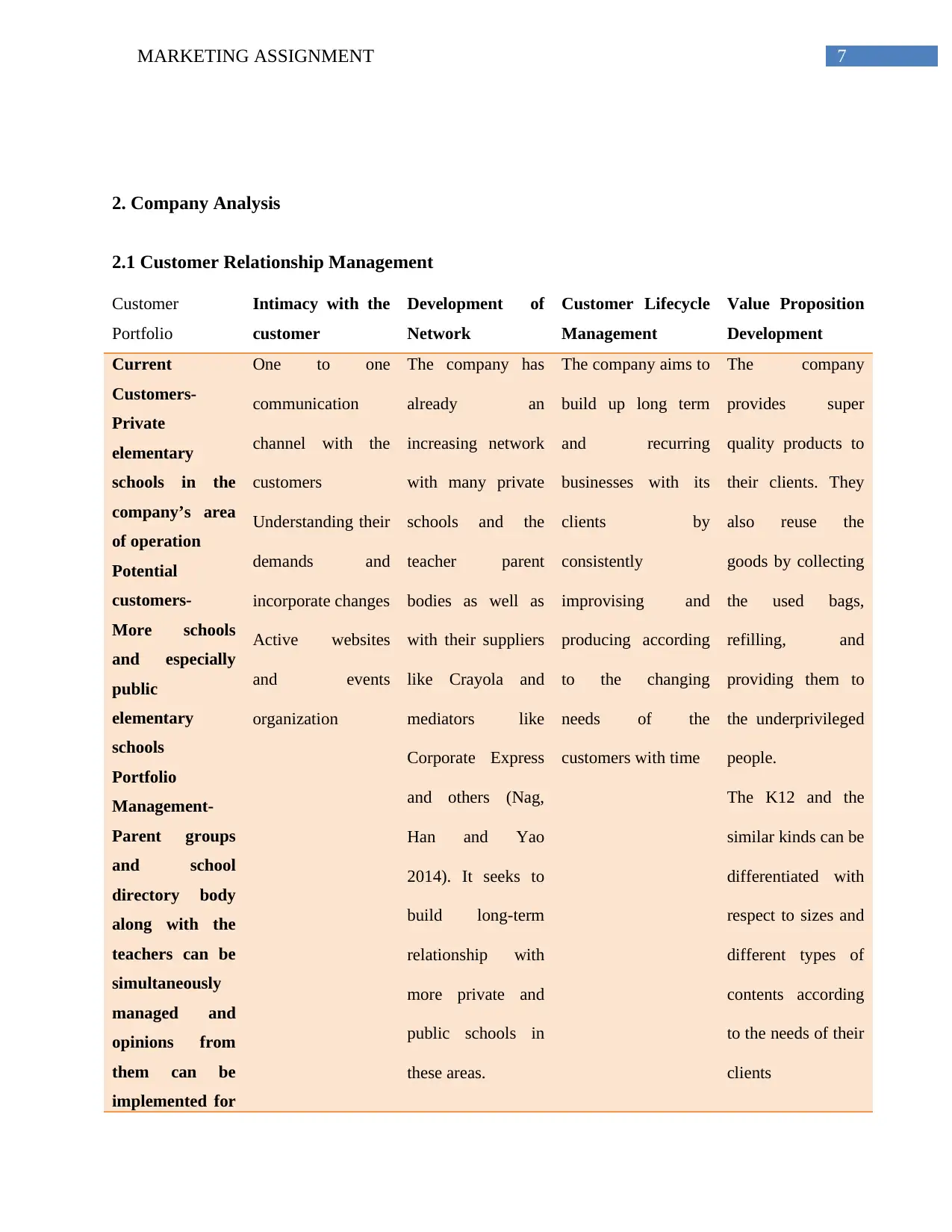
7MARKETING ASSIGNMENT
2. Company Analysis
2.1 Customer Relationship Management
Customer
Portfolio
Intimacy with the
customer
Development of
Network
Customer Lifecycle
Management
Value Proposition
Development
Current
Customers-
Private
elementary
schools in the
company’s area
of operation
Potential
customers-
More schools
and especially
public
elementary
schools
Portfolio
Management-
Parent groups
and school
directory body
along with the
teachers can be
simultaneously
managed and
opinions from
them can be
implemented for
One to one
communication
channel with the
customers
Understanding their
demands and
incorporate changes
Active websites
and events
organization
The company has
already an
increasing network
with many private
schools and the
teacher parent
bodies as well as
with their suppliers
like Crayola and
mediators like
Corporate Express
and others (Nag,
Han and Yao
2014). It seeks to
build long-term
relationship with
more private and
public schools in
these areas.
The company aims to
build up long term
and recurring
businesses with its
clients by
consistently
improvising and
producing according
to the changing
needs of the
customers with time
The company
provides super
quality products to
their clients. They
also reuse the
goods by collecting
the used bags,
refilling, and
providing them to
the underprivileged
people.
The K12 and the
similar kinds can be
differentiated with
respect to sizes and
different types of
contents according
to the needs of their
clients
2. Company Analysis
2.1 Customer Relationship Management
Customer
Portfolio
Intimacy with the
customer
Development of
Network
Customer Lifecycle
Management
Value Proposition
Development
Current
Customers-
Private
elementary
schools in the
company’s area
of operation
Potential
customers-
More schools
and especially
public
elementary
schools
Portfolio
Management-
Parent groups
and school
directory body
along with the
teachers can be
simultaneously
managed and
opinions from
them can be
implemented for
One to one
communication
channel with the
customers
Understanding their
demands and
incorporate changes
Active websites
and events
organization
The company has
already an
increasing network
with many private
schools and the
teacher parent
bodies as well as
with their suppliers
like Crayola and
mediators like
Corporate Express
and others (Nag,
Han and Yao
2014). It seeks to
build long-term
relationship with
more private and
public schools in
these areas.
The company aims to
build up long term
and recurring
businesses with its
clients by
consistently
improvising and
producing according
to the changing
needs of the
customers with time
The company
provides super
quality products to
their clients. They
also reuse the
goods by collecting
the used bags,
refilling, and
providing them to
the underprivileged
people.
The K12 and the
similar kinds can be
differentiated with
respect to sizes and
different types of
contents according
to the needs of their
clients
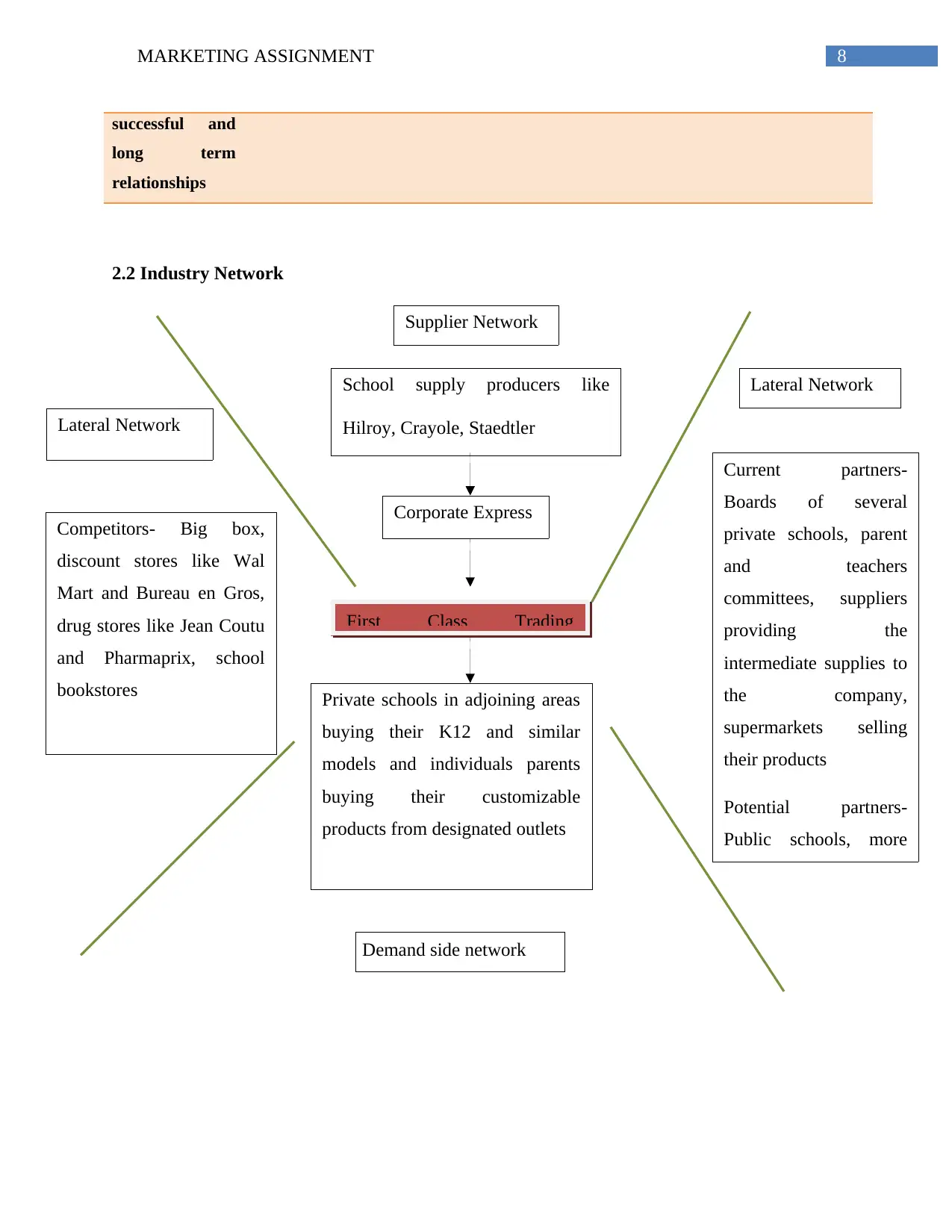
8MARKETING ASSIGNMENT
successful and
long term
relationships
2.2 Industry Network
First Class Trading
Supplier Network
School supply producers like
Hilroy, Crayole, Staedtler
Corporate Express
Lateral Network
Competitors- Big box,
discount stores like Wal
Mart and Bureau en Gros,
drug stores like Jean Coutu
and Pharmaprix, school
bookstores
Lateral Network
Current partners-
Boards of several
private schools, parent
and teachers
committees, suppliers
providing the
intermediate supplies to
the company,
supermarkets selling
their products
Potential partners-
Public schools, more
private schools and
Demand side network
Private schools in adjoining areas
buying their K12 and similar
models and individuals parents
buying their customizable
products from designated outlets
successful and
long term
relationships
2.2 Industry Network
First Class Trading
Supplier Network
School supply producers like
Hilroy, Crayole, Staedtler
Corporate Express
Lateral Network
Competitors- Big box,
discount stores like Wal
Mart and Bureau en Gros,
drug stores like Jean Coutu
and Pharmaprix, school
bookstores
Lateral Network
Current partners-
Boards of several
private schools, parent
and teachers
committees, suppliers
providing the
intermediate supplies to
the company,
supermarkets selling
their products
Potential partners-
Public schools, more
private schools and
Demand side network
Private schools in adjoining areas
buying their K12 and similar
models and individuals parents
buying their customizable
products from designated outlets
⊘ This is a preview!⊘
Do you want full access?
Subscribe today to unlock all pages.

Trusted by 1+ million students worldwide
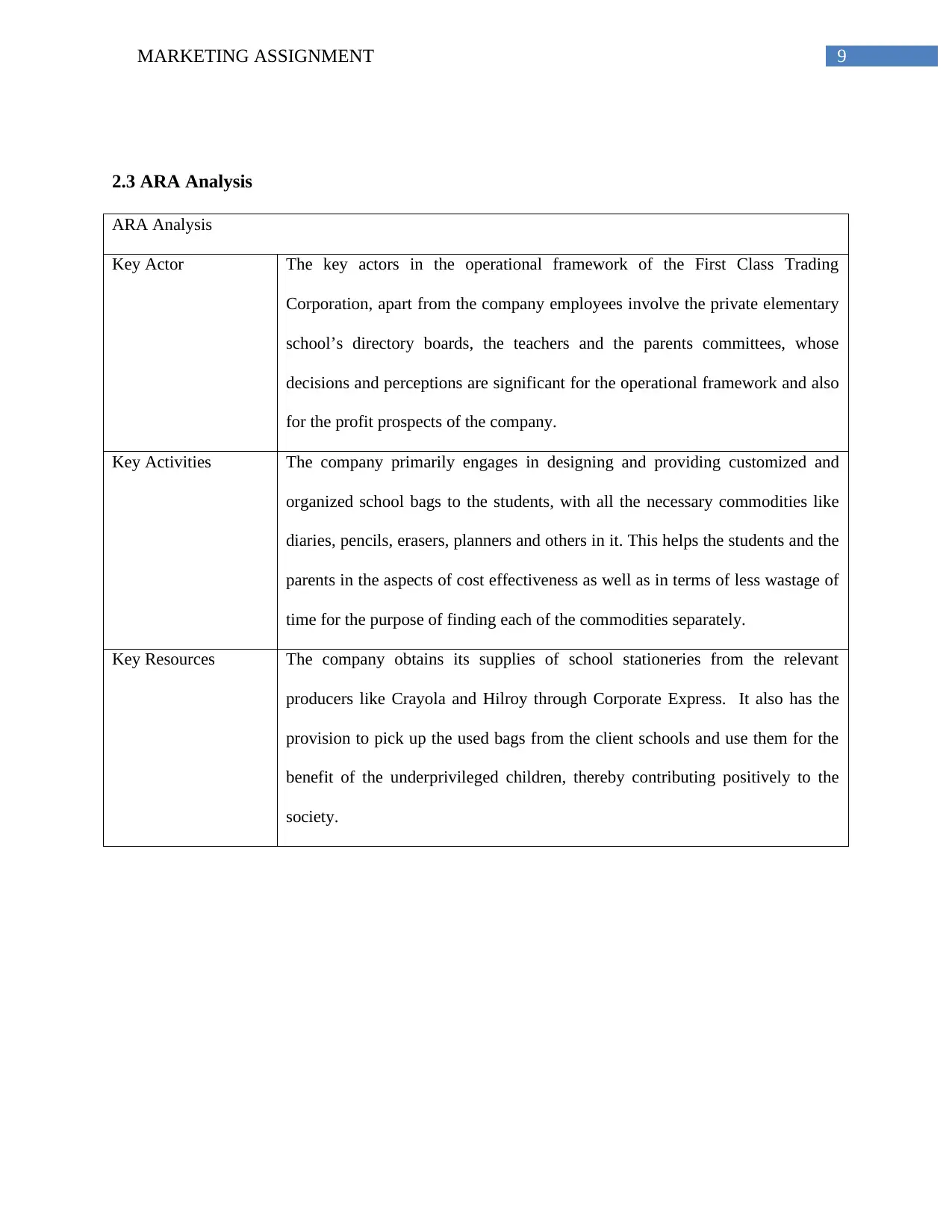
9MARKETING ASSIGNMENT
2.3 ARA Analysis
ARA Analysis
Key Actor The key actors in the operational framework of the First Class Trading
Corporation, apart from the company employees involve the private elementary
school’s directory boards, the teachers and the parents committees, whose
decisions and perceptions are significant for the operational framework and also
for the profit prospects of the company.
Key Activities The company primarily engages in designing and providing customized and
organized school bags to the students, with all the necessary commodities like
diaries, pencils, erasers, planners and others in it. This helps the students and the
parents in the aspects of cost effectiveness as well as in terms of less wastage of
time for the purpose of finding each of the commodities separately.
Key Resources The company obtains its supplies of school stationeries from the relevant
producers like Crayola and Hilroy through Corporate Express. It also has the
provision to pick up the used bags from the client schools and use them for the
benefit of the underprivileged children, thereby contributing positively to the
society.
2.3 ARA Analysis
ARA Analysis
Key Actor The key actors in the operational framework of the First Class Trading
Corporation, apart from the company employees involve the private elementary
school’s directory boards, the teachers and the parents committees, whose
decisions and perceptions are significant for the operational framework and also
for the profit prospects of the company.
Key Activities The company primarily engages in designing and providing customized and
organized school bags to the students, with all the necessary commodities like
diaries, pencils, erasers, planners and others in it. This helps the students and the
parents in the aspects of cost effectiveness as well as in terms of less wastage of
time for the purpose of finding each of the commodities separately.
Key Resources The company obtains its supplies of school stationeries from the relevant
producers like Crayola and Hilroy through Corporate Express. It also has the
provision to pick up the used bags from the client schools and use them for the
benefit of the underprivileged children, thereby contributing positively to the
society.
Paraphrase This Document
Need a fresh take? Get an instant paraphrase of this document with our AI Paraphraser
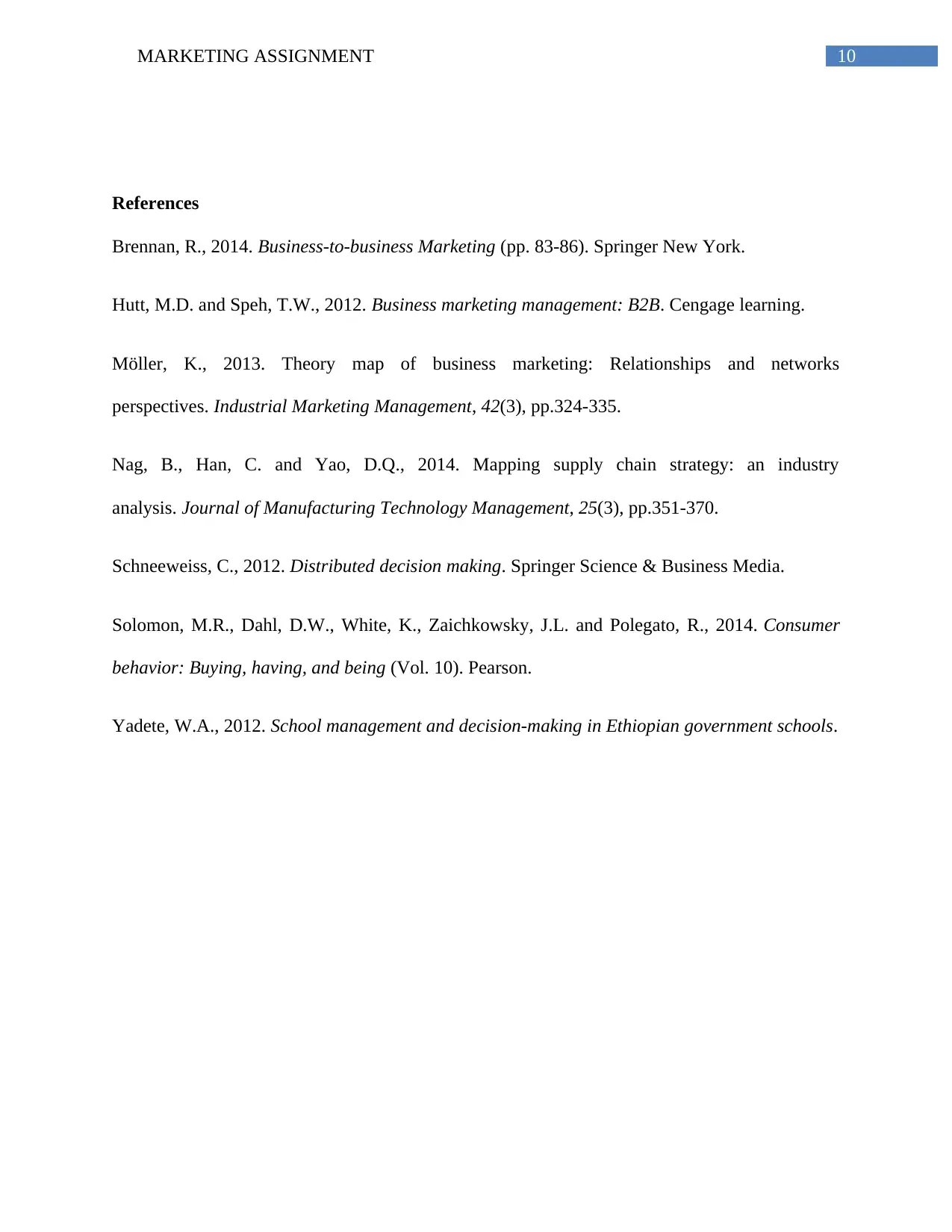
10MARKETING ASSIGNMENT
References
Brennan, R., 2014. Business-to-business Marketing (pp. 83-86). Springer New York.
Hutt, M.D. and Speh, T.W., 2012. Business marketing management: B2B. Cengage learning.
Möller, K., 2013. Theory map of business marketing: Relationships and networks
perspectives. Industrial Marketing Management, 42(3), pp.324-335.
Nag, B., Han, C. and Yao, D.Q., 2014. Mapping supply chain strategy: an industry
analysis. Journal of Manufacturing Technology Management, 25(3), pp.351-370.
Schneeweiss, C., 2012. Distributed decision making. Springer Science & Business Media.
Solomon, M.R., Dahl, D.W., White, K., Zaichkowsky, J.L. and Polegato, R., 2014. Consumer
behavior: Buying, having, and being (Vol. 10). Pearson.
Yadete, W.A., 2012. School management and decision-making in Ethiopian government schools.
References
Brennan, R., 2014. Business-to-business Marketing (pp. 83-86). Springer New York.
Hutt, M.D. and Speh, T.W., 2012. Business marketing management: B2B. Cengage learning.
Möller, K., 2013. Theory map of business marketing: Relationships and networks
perspectives. Industrial Marketing Management, 42(3), pp.324-335.
Nag, B., Han, C. and Yao, D.Q., 2014. Mapping supply chain strategy: an industry
analysis. Journal of Manufacturing Technology Management, 25(3), pp.351-370.
Schneeweiss, C., 2012. Distributed decision making. Springer Science & Business Media.
Solomon, M.R., Dahl, D.W., White, K., Zaichkowsky, J.L. and Polegato, R., 2014. Consumer
behavior: Buying, having, and being (Vol. 10). Pearson.
Yadete, W.A., 2012. School management and decision-making in Ethiopian government schools.
1 out of 11
Related Documents
Your All-in-One AI-Powered Toolkit for Academic Success.
+13062052269
info@desklib.com
Available 24*7 on WhatsApp / Email
![[object Object]](/_next/static/media/star-bottom.7253800d.svg)
Unlock your academic potential
Copyright © 2020–2025 A2Z Services. All Rights Reserved. Developed and managed by ZUCOL.





